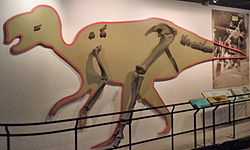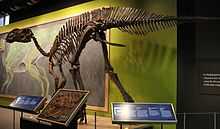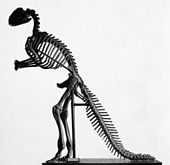Hadrosaurus
| Hadrosaurus Temporal range: Late Cretaceous, ~79.5Ma | |
|---|---|
 | |
| Displayed casts of the 35 known bones at the Philadelphia Academy of Natural Sciences | |
| Scientific classification | |
| Kingdom: | Animalia |
| Phylum: | Chordata |
| Clade: | Dinosauria |
| Order: | †Ornithischia |
| Clade: | †Ornithopoda |
| Family: | †Hadrosauridae |
| Subfamily: | †Hadrosaurinae Lambe, 1918 |
| Genus: | †Hadrosaurus Leidy, 1858 |
| Type species | |
| †Hadrosaurus foulkii Leidy, 1858 | |
Hadrosaurus (/ˌhædrɵˈsɔrəs/; from Greek ἁδρός, hadros, i.e. "sturdy" and σαῦρος, sauros, i.e. "lizard")[2][3][4][5] is a valid[6] genus of hadrosaurid dinosaur. In 1858, the only known skeleton was discovered, representing the first dinosaur species known from more than isolated teeth to be identified in North America. In 1868, it became the first ever mounted dinosaur skeleton. Hadrosaurus foulkii is the only species in this genus and has been the official state dinosaur of New Jersey, United States since 1991.
Hadrosaurus foulkii is known from a single specimen consisting of much of the skeleton and parts of the skull. The specimen was collected from the Woodbury Formation in New Jersey, USA. Using radio isotope dating of bivalve shells from the same formation, the sedimentary rocks that the Hadrosaurus fossil was found in were formed at some point between 80.5 and 78.5 million years ago.[7]
Classification
Despite the fact that the family Hadrosauridae has Hadrosaurus as its type genus, the skeleton lacks a skull and was long viewed as too incomplete to compare to other hadrosaurs for classification purposes, leading most scientists to consider it a nomen dubium, or dubious name.[6] However, a re-evaluation of the fossil material in 2011 noted several distinct characteristics of the skeleton that could allow the genus Hadrosaurus and species H. foulkii to remain in use as a valid taxon.[6]
Hadrosaurus has also traditionally served as the basis for a large sub-family called Hadrosaurinae, which was seen as a group of largely crestless group of hadrosaurs related to the crested sub-family Lambeosaurinae. However, the changing view of Hadrosaurus classification in relation to other hadrosaurs has led some scientists to re-name these subfamilies. In a 2008 study, Hadrosaurus was found to be more primitive than either lambeosaurines or other "hadrosaurines", and not a particularly close relative of classic "hadrosaurines" like Edmontosaurus and Saurolophus. As a result of this, the name Hadrosaurinae was restricted to Hadrosaurus alone, and the subfamily comprising the traditional "hadrosaurines" was re-named the Saurolophinae.[8]
Discovery


In 1838, John Estaugh Hopkins was digging in a marl pit (on a small tributary of the Cooper River in Haddonfield, New Jersey, and part of the Campanian-age Woodbury Formation) when he uncovered large bones, putting them on display at his home, also in Haddonfield. In 1858 these bones sparked the interest of a visitor, William Parker Foulke. The skeleton was dug out from the marl pit in 1858 by Foulke. The excavation site, known as the Hadrosaurus Foulkii Leidy Site, is now a National Historic Landmark. Foulke contacted paleontologist Joseph Leidy, and together they recovered an almost complete set of limbs, along with a pelvis, several part of the feet, twenty-eight vertebrae (including eighteen from the tail), eight teeth and two small parts of the jaw. Foulke and Leidy studied the fossils together, and in 1858 Leidy formally described and named Hadrosaurus foulkii in honor of his collaborator.[9]
Leidy recognized that these bones were from a dinosaur by their similarity to those of Iguanodon, discovered in England some decades before, but the skeleton of Hadrosaurus was far more complete. Leidy's monograph Cretaceous Reptiles of the United States, describing Hadrosaurus more completely and with illustrations, was written in 1860 but the American Civil War delayed its publication until 1865. Leidy reconstructed Hadrosaurus as a biped, in contrast to the view at the time that such dinosaurs were quadrupedal. The entire skeleton was completely assembled in 1868 by a team including English sculptor and naturalist Benjamin Waterhouse Hawkins and was put on display at Philadelphia Academy of Natural Sciences. The skeleton is usually kept 'behind-the-scenes' in the Academy's collections. However, from November 22, 2008 until April 19, 2009, a fully assembled cast of the skeleton and an exhibit about the science and culture surrounding the dinosaur's discovery was open to the public.

When the skeleton was first assembled, it was displayed with a plaster skull sculpted by Hawkins. Many other artists have recreated Hadrosaurus with skulls from other, related species such as Gryposaurus and Brachylophosaurus. A statue of Hadrosaurus, sculpted by Haddonfield resident John Giannotti, now stands in the center of the town of Haddonfield, commemorating its discovery there.
References
- ↑ First Dinosaur Skeleton Ever Mounted for Public Display
- ↑ Levins, Hoage. "From the Shores of a Bucolic Pond to World Fame: Haddonfield's Dinosaur". Finding the World's First Dinosaur Skeleton: Hadrosaurus foulkii. Retrieved 24 January 2011.
- ↑ "hadrosaur". Online Etymology Dictionary.
- ↑ ἁδρός. Liddell, Henry George; Scott, Robert; A Greek–English Lexicon at the Perseus Project
- ↑ σαῦρος. Liddell, Henry George; Scott, Robert; A Greek–English Lexicon at the Perseus Project
- ↑ 6.0 6.1 6.2 Prieto-Márquez, A. (2011). "Revised diagnoses of Hadrosaurus foulkii Leidy, 1858 (the type genus and species of Hadrosauridae Cope, 1869) and Claosaurus agilis Marsh, 1872 (Dinosauria: Ornithopoda) from the Late Cretaceous of North America". Zootaxa 2765: 61–68.
- ↑ Gallagher, W.B. (2005). "Recent mosasaur discoveries from New Jersey and Delaware, USA: stratigraphy, taphonomy and implications for mosasaur extinction." Netherlands Journal of Geosciences, 84(3): 241.
- ↑ Prieto-Márquez, A. (2013). "Skeletal morphology of Kritosaurus navajovius (Dinosauria:Hadrosauridae) from the Late Cretaceous of the North American south-west, with an evaluation of the phylogenetic systematics and biogeography of Kritosaurini". Journal of Systematic Palaeontology. in press. doi:10.1080/14772019.2013.770417.
- ↑ Prieto-Marquez, A., Weishampel, D.B. and Horner, J.R. (2006). "The dinosaur Hadrosaurus foulkii, from the Campanian of the East Coast of North America, with a reevaluation of the genus." Acta Palaeontologica Polonica, 51(1): 77–98.
External links
| Wikimedia Commons has media related to Hadrosaurus. |
- Hadrosaur mummy
- The discovery of H. foulkii
- Hadrosaurids on UCMP
- New Jersey State Museum website
- Joseph Leidy and Hadrodaurus foulkii at The Academy of Natural Sciences
- Hadrosaurus foulkii exhibit at The Academy of Natural Sciences